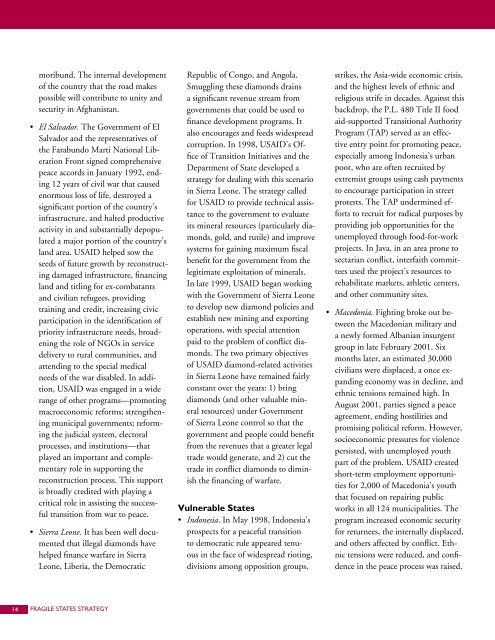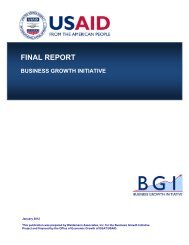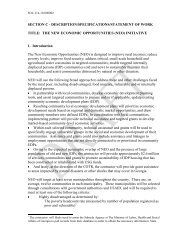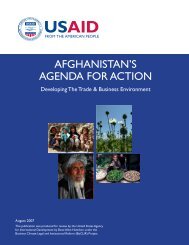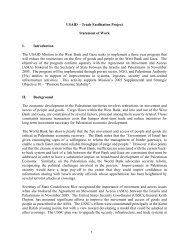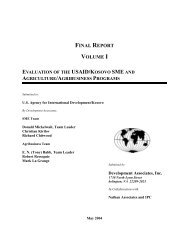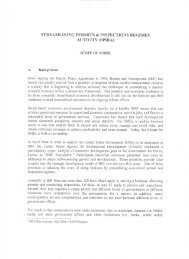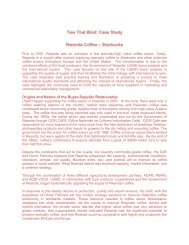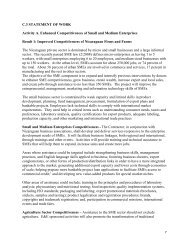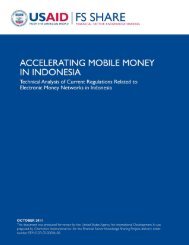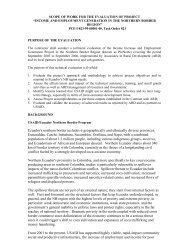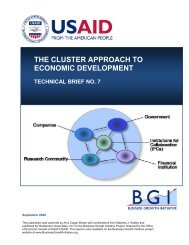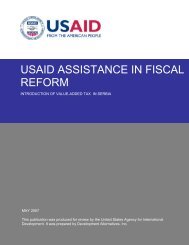USAID Fragile States Strategy - The Air University
USAID Fragile States Strategy - The Air University
USAID Fragile States Strategy - The Air University
- No tags were found...
You also want an ePaper? Increase the reach of your titles
YUMPU automatically turns print PDFs into web optimized ePapers that Google loves.
moribund. <strong>The</strong> internal developmentof the country that the road makespossible will contribute to unity andsecurity in Afghanistan.• El Salvador. <strong>The</strong> Government of ElSalvador and the representatives ofthe Farabundo Marti National LiberationFront signed comprehensivepeace accords in January 1992, ending12 years of civil war that causedenormous loss of life, destroyed asignificant portion of the country’sinfrastructure, and halted productiveactivity in and substantially depopulateda major portion of the country’sland area. <strong>USAID</strong> helped sow theseeds of future growth by reconstructingdamaged infrastructure, financingland and titling for ex-combatantsand civilian refugees, providingtraining and credit, increasing civicparticipation in the identification ofpriority infrastructure needs, broadeningthe role of NGOs in servicedelivery to rural communities, andattending to the special medicalneeds of the war disabled. In addition,<strong>USAID</strong> was engaged in a widerange of other programs—promotingmacroeconomic reforms; strengtheningmunicipal governments; reformingthe judicial system, electoralprocesses, and institutions—thatplayed an important and complementaryrole in supporting thereconstruction process. This supportis broadly credited with playing acritical role in assisting the successfultransition from war to peace.• Sierra Leone. It has been well documentedthat illegal diamonds havehelped finance warfare in SierraLeone, Liberia, the DemocraticRepublic of Congo, and Angola.Smuggling these diamonds drainsa significant revenue stream fromgovernments that could be used tofinance development programs. Italso encourages and feeds widespreadcorruption. In 1998, <strong>USAID</strong>’s Officeof Transition Initiatives and theDepartment of State developed astrategy for dealing with this scenarioin Sierra Leone. <strong>The</strong> strategy calledfor <strong>USAID</strong> to provide technical assistanceto the government to evaluateits mineral resources (particularly diamonds,gold, and rutile) and improvesystems for gaining maximum fiscalbenefit for the government from thelegitimate exploitation of minerals.In late 1999, <strong>USAID</strong> began workingwith the Government of Sierra Leoneto develop new diamond policies andestablish new mining and exportingoperations, with special attentionpaid to the problem of conflict diamonds.<strong>The</strong> two primary objectivesof <strong>USAID</strong> diamond-related activitiesin Sierra Leone have remained fairlyconstant over the years: 1) bringdiamonds (and other valuable mineralresources) under Governmentof Sierra Leone control so that thegovernment and people could benefitfrom the revenues that a greater legaltrade would generate, and 2) cut thetrade in conflict diamonds to diminishthe financing of warfare.Vulnerable <strong>States</strong>• Indonesia. In May 1998, Indonesia’sprospects for a peaceful transitionto democratic rule appeared tenuousin the face of widespread rioting,divisions among opposition groups,strikes, the Asia-wide economic crisis,and the highest levels of ethnic andreligious strife in decades. Against thisbackdrop, the P.L. 480 Title II foodaid-supported Transitional AuthorityProgram (TAP) served as an effectiveentry point for promoting peace,especially among Indonesia’s urbanpoor, who are often recruited byextremist groups using cash paymentsto encourage participation in streetprotests. <strong>The</strong> TAP undermined effortsto recruit for radical purposes byproviding job opportunities for theunemployed through food-for-workprojects. In Java, in an area prone tosectarian conflict, interfaith committeesused the project’s resources torehabilitate markets, athletic centers,and other community sites.• Macedonia. Fighting broke out betweenthe Macedonian military anda newly formed Albanian insurgentgroup in late February 2001. Sixmonths later, an estimated 30,000civilians were displaced, a once expandingeconomy was in decline, andethnic tensions remained high. InAugust 2001, parties signed a peaceagreement, ending hostilities andpromising political reform. However,socioeconomic pressures for violencepersisted, with unemployed youthpart of the problem. <strong>USAID</strong> createdshort-term employment opportunitiesfor 2,000 of Macedonia’s youththat focused on repairing publicworks in all 124 municipalities. <strong>The</strong>program increased economic securityfor returnees, the internally displaced,and others affected by conflict. Ethnictensions were reduced, and confidencein the peace process was raised.14 FRAGILE STATES STRATEGY


